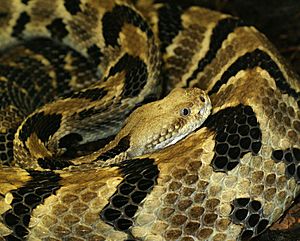Crotalus facts for kids
Quick facts for kids Crotalus |
|
|---|---|
 |
|
| A timber rattlesnake (Crotalus horridus), is a species of Crotalus | |
| Scientific classification | |
| Kingdom: | |
| Phylum: | |
| Subphylum: | |
| Class: | |
| Order: | |
| Suborder: | |
| Family: | |
| Subfamily: | |
| Genus: |
Crotalus
|
Crotalus is a group of venomous pit vipers that are found only in the Americas. You can find them from southern Canada all the way down to northern Argentina. The name Crotalus comes from a Greek word, krotalon, which means "rattle". This name refers to the special rattle found on the end of their tail. There are currently 29 different types, or species, of Crotalus snakes known to scientists.
Contents
What are Rattlesnakes Like?
Rattlesnakes come in many sizes. Some are quite small, only about 50–60 centimeters (about 20-24 inches) long. Others can grow to be very large, over 150 centimeters (about 5 feet) long! Adult male rattlesnakes are usually a little bigger than the females.
Compared to most other snakes, rattlesnakes have a heavy, thick body. However, some African vipers are even thicker. The easiest way to tell a rattlesnake apart is by the unique rattle on its tail. This rattle is made of keratin, the same material as your fingernails. When the snake shakes its tail, the segments of the rattle click together, making a warning sound.
What Do Rattlesnakes Eat?
What a rattlesnake eats depends on its size and age. Smaller rattlesnake species mostly eat lizards. When young, larger rattlesnake species also start by eating lizards. As they grow bigger and become adults, their diet changes. They begin to hunt and eat mammals like rabbits, squirrels, chipmunks, gophers, rats, and mice. Some rattlesnakes also eat birds, other snakes, and even amphibians like frogs or toads.
Who Hunts Rattlesnakes?
Even though rattlesnakes are powerful predators, they also have their own enemies. Humans are one threat to Crotalus snakes. Other snakes, like the Kingsnake, the Coachwhip, the Indigo Snake, and the Racer, will also hunt rattlesnakes.
Birds of prey, such as hawks, eagles, and owls, can snatch rattlesnakes from above. Ravens and roadrunners are also known to prey on them. Mammals like the coyote, fox, wildcat, badger, and skunk can also be dangerous to rattlesnakes.
Understanding Rattlesnake Venom
Almost all Crotalus snakes have a type of venom called hemotoxic venom. This kind of venom causes damage to the body in several ways. It can destroy red blood cells, stop blood clotting, and harm body tissue. A bite from a snake with hemotoxic venom can be very painful. While people often recover, they might not always make a full recovery.
Some rattlesnake species, like the Mohave rattlesnake (Crotalus scutulatus) and the Tiger rattlesnake (Crotalus tigris), have a different type of venom called neurotoxin. Neurotoxins are usually less painful at first, but they can act much faster and affect the nervous system. This type of venom is also found in the bites of cobras and mambas. The Eastern diamondback rattlesnake (Crotalus adamanteus) in some areas might have both neurotoxins and hemotoxins in its venom.
Different Kinds of Rattlesnakes
There are many different species of rattlesnakes. Here are some of them:
- Eastern diamondback rattlesnake, C. adamanteus
- Querétaro dusky rattlesnake, C. aquilus
- Western Diamondback Rattlesnake, C. atrox
- Mexican west coast rattlesnake, C. basiliscus
- Santa Catalina rattlesnake, C. catalinensis
- Sidewinder, C. cerastes
- South American rattlesnake, C. durissus
- Baja California rattlesnake, C. enyo
- Timber rattlesnake, C. horridus
- Mexican small-headed rattlesnake, C. intermedius
- Autlán rattlesnake, C. lannomi
- Rock rattlesnake, C. lepidus
- Speckled rattlesnake, C. mitchellii
- Black-tailed rattlesnake, C. molossus
- Western rattlesnake, C. oreganus
- Mexican lance-headed rattlesnake, C. polystictus
- Twin-spotted rattlesnake, C. pricei
- Tancitaran dusky rattlesnake, C. pusillus
- Red diamond rattlesnake, C. ruber
- Mohave rattlesnake, C. scutulatus
- Middle American rattlesnake, C. simus
- Long-tailed rattlesnake, C. stejnegeri
- Tiger rattlesnake, C. tigris
- Tortuga island diamond rattlesnake, C. tortugensis
- Totonacan rattlesnake, C. totonacus
- Cross-banded mountain rattlesnake, C. transversus
- Mexican dusky rattlesnake, C. triseriatus
- Prairie rattlesnake, C. viridis
- Ridge-nosed rattlesnake, C. willardi
Images for kids
-
The rattle of a western diamondback rattlesnake (notice the black and white coloring on the lower right)
See also
 In Spanish: Serpientes de cascabel para niños
In Spanish: Serpientes de cascabel para niños


